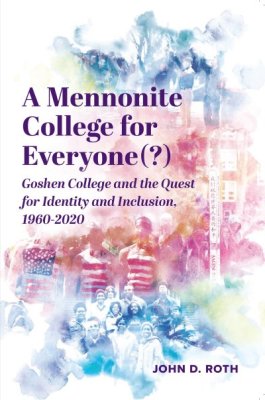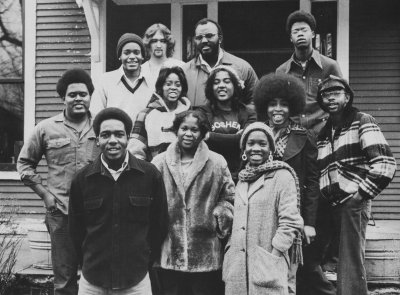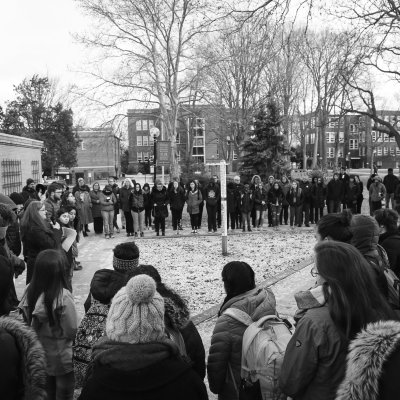A Mennonite College for Everyone(?)
About the Book

A new Goshen College history book, A Mennonite College for Everyone(?): Goshen College and the Quest for Identity and Inclusion, 1960-2020, vividly describes the transformation of a faith-based, liberal arts college as it has wrestled with questions of identity and inclusion in a context of rapid social and cultural change.

Author John D. Roth ’81, professor emeritus of history, brings the dynamic and often challenging story to life in chapters about the denominational relationships, international engagement, racial inclusion, gender and culture wars, LGBTQ+ inclusion, athletics, Latinx/Hispanic enrollment and Anabaptist stances toward patriotism and nationalism.
It asks the question: Can a progressive vision be integrated with deep conservative impulses that shape denominational and political realities? And it shows a way forward: Tell the story honestly and well, and begin the careful, courageous weighing of lessons learned.
“A Mennonite College for Everyone(?)” may be purchased for $19.99 in paperback at:
- Goshen College Box Office (in the Music Center), which is open for business Monday-Friday, 9 a.m. to 1 p.m.
- Fables Books in downtown Goshen and through their online store
All proceeds from the sale of this book will go to support diversity, equity and inclusion initiatives for students on campus.
An excerpt from the Epilogue
This article originally appeared in the Fall/Winter 2023 issue of The Bulletin.
By John D. Roth ’81, professor emeritus of history
“Right Remembering”: History as Confession . . . and Commitment
If, in the words of the grant that helped to fund this project, we wish to “reframe the institutional saga” of Goshen College in a way that helps the institution renew its sense of purpose and mission, it might be … useful to consider an approach suggested by the theologian Miroslav Volf, which he calls “right remembering.” In his book The End of Memory: Remembering Rightly in a Violent World, Volf recognizes the power of memory, especially the many ways collective memory can become a form of idolatry in which a group worships itself instead of the Creator.
Both the “dying of the light” and the “progressive triumph” approaches to the history of Goshen College run that risk. But the alternative to a distorted narrative is not to reject history, or to quit telling stories, or to think that we can escape from the burden of memory. Instead, Volf argues, the challenge is to “remember rightly.”
“Right remembering” begins with a simple commitment to factual honesty — doing everything one can to tell the story truthfully, pointing readers to the primary sources that have informed the narrative so that others might retrieve those same sources and tell the story differently. Facts, of course, never exist in isolation — they are always woven together in ways that reveal some larger argument or objective, whether implicit or openly stated. But a history of Goshen College “rightly remembered” begins with a conscious effort to be factually honest, and transparent about the sources used to support the arguments of the book.

“Right remembering” also includes a commitment to tell the story with an empathetic spirit. It begins with a posture of curiosity and compassion, seeking not only to make the foreign familiar, but also to allow that which is familiar to become foreign when seen through the eyes of another person or group. This effort to see the story from the perspective of an individual or group other than myself does not require agreement with alternative points of view. But if the narrative is to serve a purpose other than simply confirming the identity of the dominant group, then it needs to move beyond established assumptions and familiar storylines and actively seek out perspectives that have been buried or marginalized. Such a commitment is not easy. It requires an engagement of the will, the intellect, and the imagination, and a readiness to resist the temptation to invest the protagonists in the stories with more saintliness (or the antagonists with more evil) than the sources at hand can reasonably support.
Finally, “right remembering” means that we tell our stories —especially institutional stories — as a form of confession. Confession in the Christian tradition has two quite distinct meanings. The first meaning is the conscious recognition of a persistent gap between our stated ideals and the lived reality. To be sure, institutions are limited, resources are finite, good intentions can go awry, and some forms of privilege and power are inevitable. But writing a history as a form of “confession” must go beyond merely recognizing our finitude. It calls us to not only acknowledge an institution’s failure to achieve its stated goals, but also to name the specific ways in which entrenched attitudes, assumptions, habits and self-interest actively conspired against attaining those goals, and to recognize that those same attitudes, assumptions, habits and self-interests remain deeply embedded in the structures of an institution long after they are named and lamented. Yet in its own imperfect way, Goshen College has dared to risk transforming a home that was once a place of comfort for white middle-class Mennonites into a place that is more welcoming to others.
Looking Ahead
The challenges confronting small liberal arts institutions like Goshen College today are daunting: economic models are shifting; the cultural divisions in American society remain deep; technology offers new possibilities and challenges; American Christianity is undergoing profound changes that have deeply impacted the Anabaptist-Mennonite tradition; and racist currents run deep in American culture and remain embedded in structures of institutional life. Institutional survival is never guaranteed.
Goshen College, like all institutions, is fully embedded in these realities. Yet the story of Goshen College is not reducible to these realities. In the face of these challenges, a stubborn spark of idealism continues to burn brightly— a view of education as “Culture for Service;” a self-critical impulse inspired by a vision of equality, justice and love; and a commitment to honor the image of God in every member of the community. As board members, administrators and faculty at Goshen College continue that conversation in the future, they might be guided and inspired by the words of Goshen College faculty member Ruth Krall. Speaking at a faculty workshop in 1991 titled “Community and Diversity: Can We Have Both?” Krall answered the question posed by the workshop with a resounding “yes”:
As faculty members of a Christian institution, the soundest reason for pursuing a multicultural curriculum has to do with love, . . . learning to hear the pain of the dispossessed who have lost their histories within the dominant history; to hear the shattered communal realities of individuals and groups who do not feel included in the dominant community; to see the absences of the disinherited from our ways of knowing; to learn about the realities of others. Christian love means learning to acknowledge our power and our privilege. Christian love . . . does not demand uniformity or conformity. Rather, Christian love celebrates diversity and complexity, seeking truth and wisdom in all places. It is because of the law of love that we must re-examine ourselves and our teaching . . . our styles of pedagogy, the content of our courses, our methods of generating new information, and the patterns we use to govern our communal relations. . . .”

The love described by Krall goes beyond mere hospitality. As Goshen College alumna and author, Sofia Samatar ’94, has written in The White Mosque: A Memoir, a moving reflection on place, religion and identity, “What’s needed . . . is the transformation of a home into an alien place.” This, of course, is not how we usually think of home. We want our homes to be comfortable, not spaces of vulnerability; we want homes to be places of refuge and rest, not settings where we are confronted with uncomfortable realities or asked to share space with newcomers or strangers. Yet in its own imperfect way, Goshen College has dared to risk transforming a home that was once a place of comfort for white middle-class Mennonites into a place that is more welcoming to others.
For some alumni and stakeholders, that process has been painful. A place that once felt like home now seems alien. Yet new forms of community are emerging at Goshen College today that are more open to the stories of women, students of color, those in the LGBTQ+ community, students from other Christian traditions, students from other religions and students who claim no religious affiliation. And these new forms of diversity need not be “alien” if those, like me, who occupy positions of power and privilege are open to receiving them as a gift — as signs of transformation, renewal and new life.




